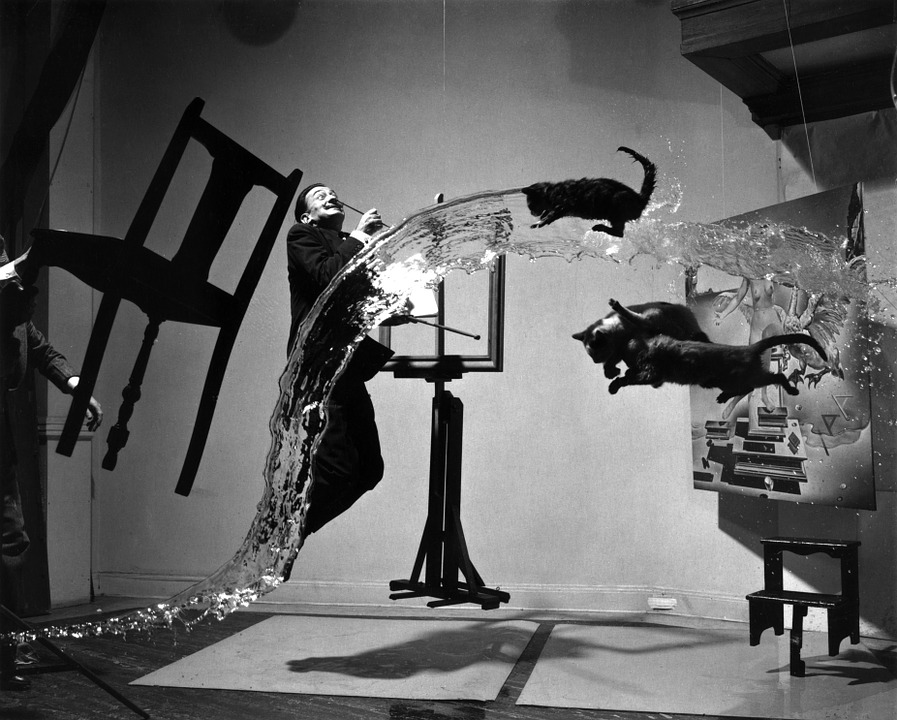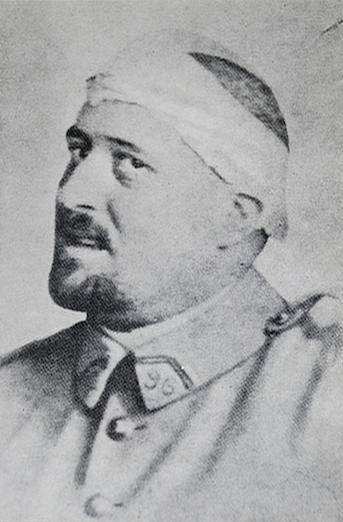
Ever since Salvador Dalí broke the window at Bonwit Teller in New York City and came sliding out onto Fifth Avenue in a bathtub, America has equated his fantastic art with surrealism. In fact, surrealism began as a literary movement—its visual art was an afterthought, a depiction of a world already described by words.
However, a number of artists who were in agreement with the poets associated themselves with the surrealist movement and endeavored to put its various methods of expression into practice. Recourse to the imaginary, to dreams, to the unconscious and to chance stimulated and inspired a number of important painters . . . to such an extent that it is not incorrect today to speak of surrealist painting or art, always bearing in mind that it is not a question of a school or a formal movement, but of a spiritual orientation.
—Patrick Waldberg, Surrealism, 1966
This "spiritual orientation" was provided by the early surrealist writers: primarily André Breton, but also Paul Eluard, Louis Aragon, René Crevel, Robert Desnos, Antonin Artaud, Jacques Rigaut, and Tristan Tzara, to name a few. Films by Luis Buñuel and Jean Cocteau were influenced by surrealist theory, as were the disciplines of philosophy and politics that followed it.
 Surrealism has its roots in the French Symbolist poets of the late nineteenth century: Rimbaud, Lautréamont, Baudelaire, Paul Valéry, Stéphane Mallarmé, and novelist Raymond Roussel. Its sources are as diverse as Alfred Jarry, Charlie Chaplin, and Guillaume Apollinaire. Inspired in part by Freud, the surrealists explored the realm of the unconscious using dreams, trance, and automatic writing to subvert—and point out—the limitations of the rational. They stressed the centrality of chance in life, and the right of the individual to question their relationship to society, a tenet that would later prove vital to the philosophy of Sartre.
Surrealism has its roots in the French Symbolist poets of the late nineteenth century: Rimbaud, Lautréamont, Baudelaire, Paul Valéry, Stéphane Mallarmé, and novelist Raymond Roussel. Its sources are as diverse as Alfred Jarry, Charlie Chaplin, and Guillaume Apollinaire. Inspired in part by Freud, the surrealists explored the realm of the unconscious using dreams, trance, and automatic writing to subvert—and point out—the limitations of the rational. They stressed the centrality of chance in life, and the right of the individual to question their relationship to society, a tenet that would later prove vital to the philosophy of Sartre.
Historically, the greatest barrier to the spread of surrealist writing in America is that the most important works remained untranslated until well after their original publication. And even then, surrealist literature stayed within intellectual circles, unlike surrealist art, which was immediately accessible to everyone.
Despite this handicap, surrealist writing has had a profound influence on modern thought. In America, the most obvious beneficiaries were the Beats—writers like Jack Kerouac, who often employed automatic writing and dream, and William Burroughs, who used his "cut-up" technique to write Naked Lunch. And although Allen Ginsberg's most famous poem is called "Howl," Tristan Tzara's poem of the same name was performed in front of a murderously enraged audience, years before Ginsberg was born.
So let's step back in time and find out: just what is this—surrealism—anyway?
It would not be good for everyone to read the pages which follow; only the few may relish this bitter fruit without danger. So, timid soul, before further penetration of such uncharted steppes, retrace your steps, do not advance. Hear my words well: retrace your steps, do not advance. . . .
—Comte de Lautrémont, Les Chants de Maldoror
 After a head injury in World War I, Guilliaume Apollinaire underwent surgery that saved his life. But friends felt it also changed him, from bold, exuberant, and openhearted to cautious, even suspicious at times. The literary and social rebel began talking openly of his desire to be accepted by the staid French Academy.
After a head injury in World War I, Guilliaume Apollinaire underwent surgery that saved his life. But friends felt it also changed him, from bold, exuberant, and openhearted to cautious, even suspicious at times. The literary and social rebel began talking openly of his desire to be accepted by the staid French Academy.
Brilliant, flamboyant, and influential, Apollinaire was the indefatigable champion of modernism: the "rocket signal" of the "modern spirit in art, literature and thought." In his youth, he befriended such literary rebels as Alfred Jarry, Max Jacob, and Blaise Cendrars. He resurrected the writing of the Marquis de Sade, and defended, explained, and popularized cubism and fauvism as well as the painting of Henri Rousseau. Apollinaire was always ready for a new cause—the more scandalous the better—as with his embracing of the Italian futurists. His own futurist manifesto "shit on" critics as it calls for the suppression of history and encourages the new generation of writers Apollinaire called the "New Spirit" in literature and art.
But it was also part of the great web he was gradually weaving, with himself like a spider at its centre, which we recognise ever more clearly as the years go by to be the pattern of the twentieth century.
—Guilliaume Apollinaire
The day after Apollinaire's wartime surgery, a stiff, formal young medical student called André Breton paid him a visit. Breton had with him a few poems he had written in the manner of symbolism, following his mentor Paul Valéry. Breton was obviously very talented, and Apollinaire did all he could to help him discover his own voice by introducing him to other up-and-comers like Philippe Soupault—a delicate young man who enjoyed pranks, practiced indifference, and possessed a deadpan sense of humor.
While assigned to a hospital in Nantes, Breton also met Jacques Vaché, who mocked him and his heroes, and expressed complete scorn for society. Vaché's message was simple: "Accept nothing, trust no one, ridicule everything." He had many eccentricities, like speaking in Ubuesque cadences or with an affected English accent. He never shook hands, and would leave friends without farewell (or ignore them altogether). Vaché also loved to create false identities for himself, wearing various combinations of the military uniforms he had acquired.
When Vaché was sent back to the war front, he wrote letters to Breton full of sarcasm, wit, lies, broken syntax, imaginative leaps, and the first whiff of what Breton would later call automatic writing. He called it umor, what would later be called "humor of the absurd" by those for whom World War I had rendered all values meaningless.
During his transfer to a neuropsychiatric center in the summer of 1916, Breton discovered the writing of Freud, and began to think about dream and the subconscious mind—especially after caring for soldiers whose minds had been destroyed by the war. The powerful and strange images that emerged from their disturbed psyches fascinated Breton, and "the relationship between the illusions of mad persons and the creative processes of art absorbed him for years."
Louis Aragon, another literature-minded medical student, met Breton at this time, and soon they became so close it was said that "Aragon's heart beats in Breton's breast"; together with Soupault, the three became inseparable. They enjoyed going to the movies, especially the films of Musidora (Jeanne Roques) whose work expresses an erotic modern sexuality. "This heady brew of novelty, danger, transgression, and sex would become the basis for the surrealists' entire concept of love," wrote Breton biographer Mark Polizzotti.
Aragon introduced Breton to the dark, overlooked Gothic masterpiece The Cantos of Maldoror, published in 1869 by the mysterious "Comte de Leautréamont" (Isidore-Lucien Ducasse). Breton was instantly attracted to its hallucinatory content and violent, dismissive style, which pits the individual against God—and attacks poetic language, craft, and attitude.
Meanwhile, after recovering from his injury, Apollinaire was reassigned to the censor's office in Paris, where he observed the slow recovery of the city's literary and arts community. Pierre Reverdy's Nord-Sud and Pierre Albert-Birot's SIC were the major avant-garde journals of the war years. Nord-Sud was open to the practitioners of "literary cubism," including Breton and company, as well as to the anarchy of the so-called "Dada" championed by Tristan Tzara of Zurich.
In his description of the ballet Parade, written by Jean Cocteau, with sets and costumes by Picasso, music by Eric Satie, choreography by Léonide Massine, and performed by Serge Diaghilev's Ballets Russes, Apollinaire coined the term sur-realism in May of 1917—a fitting tribute to this new thing emerging along with the new century.
As with his "new spirit," surrealism was Apollinaire’s effort to harness the energies of the younger generation and lead the post-war literary and artistic movements. The truth, however, is that Jacques Vaché was right: Apollinaire had lost touch with what was motivating young writers and artists.
Contracting influenza in the autumn of 1918, Apollinaire lay on his death bed as a crowd, gathered in the street below, restlessly anticipated the end of the war, chanting, "Down with Guillaume! Down with Guillaume!" referring to the Kaiser of Germany. But in his delirium, Apollinaire thought they meant him. "Save me, Doctor," he begged before dying. "I still have so much to say!" Two days later the "Great War" was over.
Within two months, Jacques Vaché was also dead, of an overdose of opium following an evening celebrating his imminent release from the army. His death had a profound effect on the course Surrealism would take. Like a martyr, Vaché's death made him immortal: he could never sell out or contradict Breton, the "Pope of surrealism." Vaché's writings would be used to reinforce the anarchy and rebelliousness of Dada, then Surrealism, and would serve as a touchstone for Breton, who returned to them like a preacher to scripture through the coming years.
Modernity is also both constant and murdered each night—But we don't recognize Apollinaire anymore, or Cocteau . . .—because—we suspect them of making art too consciously, of slicing romanticism with telephone wire and not knowing the dynamos.
—Jacques Vaché
The day Breton learned of Vaché's death, he also received his first letter from the avatar of Dada, Tristan Tzara. For a time, Tzara's bold ideas and outrageous activity ("DADA DOES NOT MEAN ANYTHING!" he shouted in his Dada Manifesto, 1918) helped fill the gap left by Vaché's sudden departure. Artists and writers returning from the trenches took up the cry, angry with the culture that had started the war and callously thrown them into the meat grinder; Dada allowed them to show their disgust.
For his part, for the next few years Breton and his gang of literary thugs instigated fights; broke up readings, concerts, and shows; held public readings of obscene and unpatriotic poems; and all around tore up the landscape. This might have gone on forever, except Tzara and Breton started butting heads. But even outside the posturing, Dada's anarchic rage, like a fire that clears a field for the next season's planting, could never have lasted. For more on this movement, see A Short History of Dada.
In mid-1919, Breton and Soupault spent a week on the "Magnetic Fields," a great experiment employing a technique Breton called "automatic writing" to record the images of the subconscious mind without interference from the conscious—to somehow write without writing. The two were surprised by the comic qualities and freshness of the language that resulted. Avoiding the "I" of the author, automatic writing offered a way into the unconscious, a route around logic.
The lake one traverses with an umbrella, the disturbing rainbow coloring of the earth, all that kind of thing makes one want to disappear. A man cracks nuts while walking, and folds himself up at times like a fan. He makes his way to the drawing-room where the ferrets have preceded him. If he arrives by closing-time, he will see the submarine gratings opening to let the honeysuckle boat enter. Tomorrow or the next day, he will go back to fetch his wife, who awaits him while sewing up lights and stringing tears.
—André Breton, The Magnetic Fields
Breton later declared The Magnetic Fields, published in May 1920, as the very first surrealist writing. Many years later, Louis Aragon would describe the book as "the moment . . . on which the entire history of writing pivots." Even so, a complete English translation of Les Champs Magnétiques would not be available for another 65 years.
 Along with Soupault and Aragon, Breton met often with Paul Eluard and his wife Gala, Robert Desnos, René Crevel, Benjamin Péret, and Antonin Artaud—to name a few who passed through those doors of the Certa Café in Paris. Together, they explored dream, seance, trance, automatism, sleeping fits, and “the receptiveness of chance," using every technique to break the chain of thought, to find new associations, new meaning.
Along with Soupault and Aragon, Breton met often with Paul Eluard and his wife Gala, Robert Desnos, René Crevel, Benjamin Péret, and Antonin Artaud—to name a few who passed through those doors of the Certa Café in Paris. Together, they explored dream, seance, trance, automatism, sleeping fits, and “the receptiveness of chance," using every technique to break the chain of thought, to find new associations, new meaning.
Calling themselves the Littérature Group at first, then the Vague Movement, they eventually settled on Apollonaire's "surrealism." Breton's Manifesto of Surrealism “is a call to liberation, an attempt to save man, 'that inveterate dreamer,' from the 'lusterless fate' imposed on him by centuries of stifling Greco-Latin logic.”
For the group, at first visual art was an afterthought, considered too labored and not "automatic" enough to be properly surrealist. But with Dadas like Marcel Duchamp, Max Ernst, Hans Arp, and Man Ray showing up in Paris, established artists like Georgio de Chirico, Picasso, and Francis Picabia using Surrealist techniques, and newbies like Joan Miró, Salvador Dali, and Yves Tanguy embracing their ideas, Breton reconsiders in his Surrealism and Painting. “For Breton,” Palozotti continues, “Painting, like poetry, was not a matter of visual technique, but the externalization of a 'purely internal model.' It was the artist's internal vision that engaged his interest, the ability to make him see that 'which is not visible.'”
The first exhibit of Surrealist painting was held November 13, 1925—at midnight—featuring the work of Man Ray, Hans Arp, Paul Klee, André Masson, Max Ernst, Joan Miró, Giorgio de Chirico, and Pablo Picasso. Soon after, the Galerie Surréaliste opened near the School of Fine Arts.
To stay relevant politically, Breton eventually flirted with the ideas of the Communist Party, before finally admitting Surrealism would never be able to conform to party discipline. The final break came at the 1935 Congress of Writers held in Paris, where it was asserted that "art's only function was to serve revolutionarty propaganda," writes Mark Polizzotti. Breton's reply to the contrary "stressed that truly revolutionary literature could follow no dictate other than absolute freedom of expression,"
To prove surrealism's credentials as a revolutionary movement, Breton and his colleagues continued disrupting events they disagreed with, conducting “trials” of rivals, causing major scandal, violently disrupting lectures, performances and literary events, and trashing banquet rooms.
The Surrealists despised all those virtues that mainstream French society held dear: family, religion, patriotism, and conformity; most of all, they despised the boorishness and arrogance of the ruling classes.
—Mark Polizzotti
 The group came up with a game called Exquisite Corpse, and published automatic texts called Soluble Fish. Convening what they called the Congress of Paris, they tried to spread their ideas further by opening a Bureau of Surrealist Research, publishing journals like La Révolution Surréalist, Le Surréalisme au Service de la Révolution, and the International Bulletin of Surréalism.
The group came up with a game called Exquisite Corpse, and published automatic texts called Soluble Fish. Convening what they called the Congress of Paris, they tried to spread their ideas further by opening a Bureau of Surrealist Research, publishing journals like La Révolution Surréalist, Le Surréalisme au Service de la Révolution, and the International Bulletin of Surréalism.
Atonin Artaud brought Surrealism to the theater and Luis Bunuel, with Dalí's help, produced the groundbreaking films Un Chien Andalou and L'age D'or—which was so scandalous that authorities confiscated the film print, and its underwriter was threatened with excommunication by the Catholic Church.
Throughout it all, Breton kept an iron grip on the surrealists. “It was his personal magnetism,” notes Palozotti, “that held together the disparate elements of his circle.” Likewise, the Pope of Surrealism excommunicated anyone failing or displeasing him—a fate shared eventually by nearly all his colleagues, even Aragon, Eluard, and Dali.
Still, the Surrealists continued to influence intellectual life throughout the mid-twentieth century, with major art exhibitions in London, New York, and Paris, as well as an international series of lectures by Breton.
After World War II, Breton continued promoting Surrealism’s pugnacious revolt, fighting Stalinists, existentialists, and, worst of all, sellouts to the establishment (he scornfully refused the Grand Prize of the City of Paris, worth 300,000 francs). In the 1950s, Breton fought off an attack on his leadership by young bucks who accused him of being a traitor to surrealism, to which he angrily decreed, "I am Surrealism!"
Breton died in 1966. Initially, the 1968 student riots in Paris drew upon the ideas of Surrealism, but ironically, its greatest public explosion was also the beginning of its final decline. A year later, surrealism was officially disbanded.
Of course, Surrealism is far from dead. Artists and writers the world over continue tapping the fantastic, the unanticipated, the nonconformist, the revolutionary. The Surrealists opened up the unconscious mind for examination and, as with Pandora, no one can put it back in its box.
Beauty will be CONVULSIVE or will not be at all.
—André Breton
